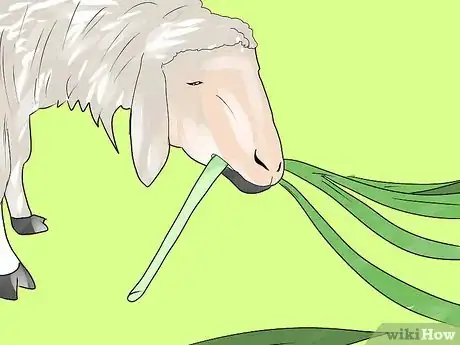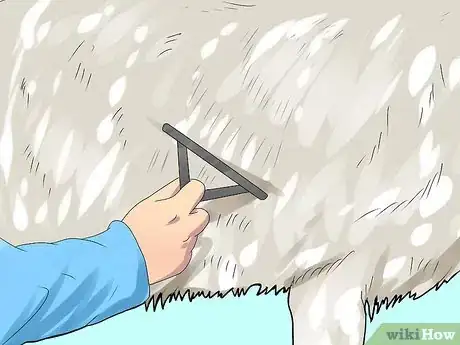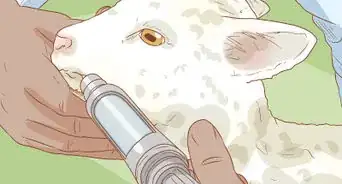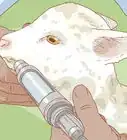wikiHow is a “wiki,” similar to Wikipedia, which means that many of our articles are co-written by multiple authors. To create this article, 38 people, some anonymous, worked to edit and improve it over time.
There are 7 references cited in this article, which can be found at the bottom of the page.
wikiHow marks an article as reader-approved once it receives enough positive feedback. This article received 14 testimonials and 93% of readers who voted found it helpful, earning it our reader-approved status.
This article has been viewed 373,079 times.
Learn more...
Raising sheep is rewarding - whether it be for one's livelihood, as a source of homegrown food or as a hobby. But success in raising sheep requires good planning in advance and solid, continual management of the sheep farm. Here are some starting pointers to help the beginner who is starting out with sheep raising. More complex topics on sheep raising will be added over the course of time.
Steps
-
1Decide the reason why you want to keep sheep. Sheep are kept for a number of reasons - for reasons of earning a living from their wool, hides, meat and milk; for reasons of hobby farming to obtain organic homegrown meat and for their other products; for vegetation control; or to be a pet. Some people even like to raise sheep as a replacement for empty nest syndrome. It is important to understand from the outset that you cannot try to do everything with this multi-purpose animal because different breeds are more suited to one aspect or other and the pasture, feed and production practices will vary according to what you want the sheep for. Unless you have the necessary time, appropriate experience, adequate resources and appropriate pasture, don't over-extend![1]
-
2Consider if you have the financial resources and time resources to raise sheep. Finances involved in setting up a sheep-breeding operation include the cost of the sheep, the cost of fencing, any feed required, vaccinations and vet checks and transportation costs. In addition, any requirement to stockpile food and provide a shelter for lambing and very poor weather needs to be taken into account.Advertisement
-
3Choose a breed within these categories:
- Wool breeds - Merino, Rambouillet, etc.;
- Meat breeds - North County Cheviot, Southdown, Dorset, Hampshire, Suffolk, and Texel etc.;
- Dual purpose breeds (both wool and meat) - Columbia, Corriedale, Polypay, and Targhee etc.; and
- Triple purpose breeds (milk, wool and meat) - mainly in Europe.
-
4Decide how many sheep you will purchase. Where you are and the productivity of your land will determine how many sheep you are able to sustain. Additionally, if you are seeking to make a profit from the sheep, you will need to factor in the market prices and the likely returns. In many places, it is very hard to make a profit from sheep raising on a small scale. It becomes even more difficult when the environment includes a harsh winter and additional feed and shelter must be provided for the sheep.
-
5Create a suitable environment for the sheep. Determine how much land you have available for your sheep. A rough rule of thumb is 5 ewes per acre.[2]
-
6Some organic sheep breeders believe it is possible to run as many as 18 sheep per hectare. The pasture must also be productive. Provide adequate fencing around the area to prevent wandering and to prevent dog (tame and feral) or other animal attacks. Provide some form of simple shelter for the sheep - adult sheep are fairly hardy provided you have selected the right type for the weather in your region.
-
7Order your chosen breed from a certified breeder. Purchase sheep breeds from recognized breeders. There should be a local or national sheep breeder's association that can assist you to find the names of breeders. Check online or in phone directories.
-
8Bring your sheep home. If you can have the sheep delivered, this is obviously easier. If you must collect them yourself, hire or purchase a suitable sheep trailer for safe transportation. If you need to make several trips, make sure the breeder is not too far away from you or you may need to make arrangements for overnight accommodation for you and the sheep.
-
9Feed them when required. The key to feeding sheep is to ensure good quality pasture. Poorer pasture should be supplemented with hay, specialized pellet feed and salt lick blocks. When sheep are unable to graze, such as during winter when snow is on the ground or during a drought when pasture is poor or non-existent, you will be obliged to feed the sheep daily. This is a time-consuming process, so consider this possibility if you are not farming full-time.[3]
-
10Make sure there is always fresh water. Ensure a steady supply of water, usually in the form of a long trough accessible by many sheep at once. Check regularly that the water is being recycled daily (if electrically driven by pump) or ensure to change the water by hand daily. If you don't they will get sick.[4]
-
11Comb them and wash the sheep regularly. If you are raising sheep for wool, showing, or as a pet, regular grooming ensures a healthy and tidy fleece.[5]
-
12Keep the sheep wormed and healthy. Ensure that the sheep are wormed regularly with a commercial worming paste suitable for sheep. Other considerations include dipping sheep to prevent pest infestation and in some places, tails are docked as a precaution against fly-blown disease. If you are in an area subject to foot-and-mouth disease outbreaks, take appropriate precautions to protect your sheep. Seek veterinarian advice on the best and most humane procedures for protecting your sheep against disease.
Community Q&A
-
QuestionWhere is the best place to keep a sheep?
 Community AnswerOutside, with lots and lots of grass. Sheep love to graze. In the winter time, get some good quality dust-free hay. And don't forget a shelter. Your sheep always needs a dry clean bed to rest on too.
Community AnswerOutside, with lots and lots of grass. Sheep love to graze. In the winter time, get some good quality dust-free hay. And don't forget a shelter. Your sheep always needs a dry clean bed to rest on too. -
QuestionHow many sheep can I raise with 3 acres?
 Community AnswerIt is suggested to stick to 5 ewes per acre, so 15 ewes would be suitable for 3 acres.
Community AnswerIt is suggested to stick to 5 ewes per acre, so 15 ewes would be suitable for 3 acres. -
QuestionWhat paperwork is needed to start raising sheep?
 Community AnswerIn all honesty, just the green kind. The only other kind of paperwork you would need is registration papers if you are going to have a registered flock, but the breeder you are buying from will provide those papers.
Community AnswerIn all honesty, just the green kind. The only other kind of paperwork you would need is registration papers if you are going to have a registered flock, but the breeder you are buying from will provide those papers.
Warnings
- Always have fresh water for your sheep to drink.⧼thumbs_response⧽
- Make sure you are in a position to care for the sheep for a while.⧼thumbs_response⧽
- Dogs and foxes are number one enemies of lambs. Make sure that adequate precautions are taken ahead of lambing to keep predators out of the birthing area.⧼thumbs_response⧽
- Make sure that you are permitted to raise sheep where you are.⧼thumbs_response⧽
- Order only from a certified breeder.⧼thumbs_response⧽
- Know the price of hay; and see if it works in your budget.⧼thumbs_response⧽
Things You'll Need
- Wool shears
- Reference book
- Sheep shampoo
- Sheep comb
- An agricultural zone to raise them in
- Fodder
- a sheep.
References
- ↑ Schoenian, Susan, Sheep 201: A Beginner's Guide to Raising Sheep
- ↑ https://smallfarms.cornell.edu/2010/07/how-to-get-started-with-sheep/
- ↑ http://www.sheep101.info/eating.html
- ↑ http://www.sheep101.info/201/feedwaterequip.html
- ↑ https://animals.mom.me/grooming-sheep-3091.html
- More info on sheep
- Breeds of sheep - Oklahama State University list of sheep breeds









































































